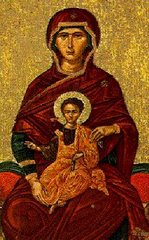 In creating Venn Diagrams to compare Sacred Scripture with a Newspaper one of the key observations was that both of these collections of documents are made up of different sections, and that interpreting each section accurately requires considering the context.
In creating Venn Diagrams to compare Sacred Scripture with a Newspaper one of the key observations was that both of these collections of documents are made up of different sections, and that interpreting each section accurately requires considering the context.Now we will turn to four distinct ways of interpreting scripture – methods the Church has used for centuries. The Catechism outlines these four “senses” of scripture in paragraphs 115 – 118. (You have to scroll down quite a bit.)
1. Literal – the literal sense of scripture based on what the words of the text say. This is essentially taking the text at face value. It means what it says.
The remaining senses are divisions of what is called the Spiritual Sense of Scripture.
2. Allegorical – the allegorical sense treats the passage as an allegory, that is to say a story with a deeper meaning, often one that can use symbolism to convey truth.
3. Moral – the moral sense instructs us as to what is right (good) and what is wrong (evil). It then prompts us to Act in a Just manner. A moral interpretation of a passage usually contains the words “should” or “ought”.
4. Anagogical – the anagogical sense leads us to an understanding of the eternal meaning of the passage, that is, what bearing it has on our eternal destiny. This sense deals with Eschatology – the study of the last things, of which there are four. I call these the “Final 4”:
1. Death – we all die. Yes, all of us.
2. Judgment – we will all be judged by God
3. Heaven – the eternal communion with God enjoyed by those judged faithful and virtuous.
4. Hell – the eternal separation from God suffered by those judged to have rejected God’s mercy and love.
* Note – Purgatory is not included in this list because purgatory is not a final place, but a temporary one that precedes entrance into heaven.
Until next time,
Ad Jesum Per Mariam.
Mr. B.

No comments:
Post a Comment